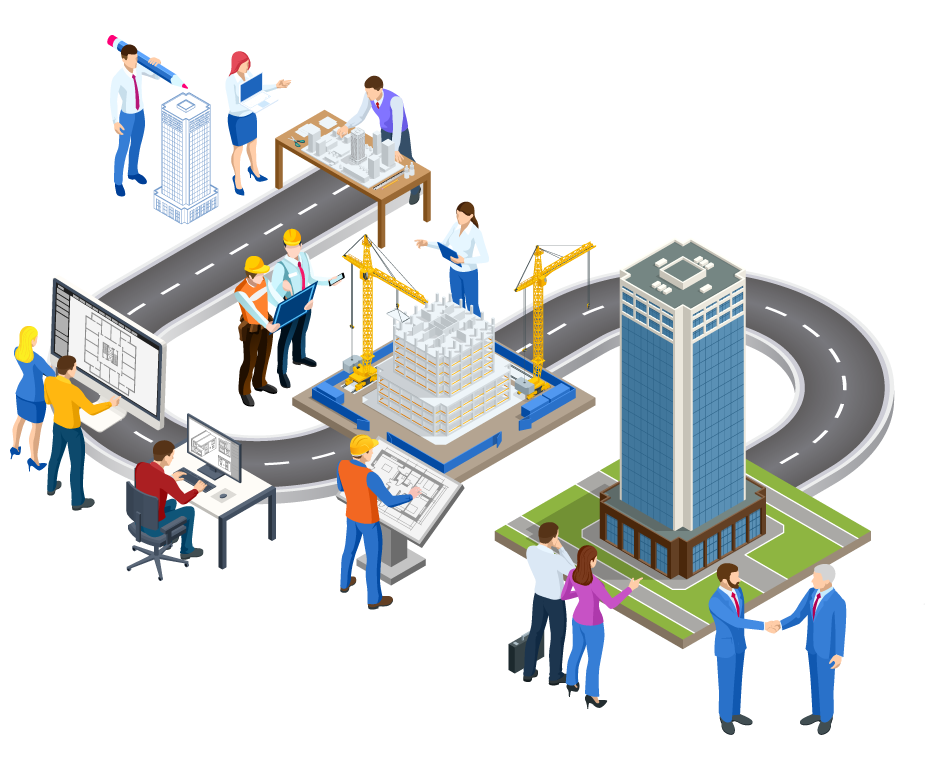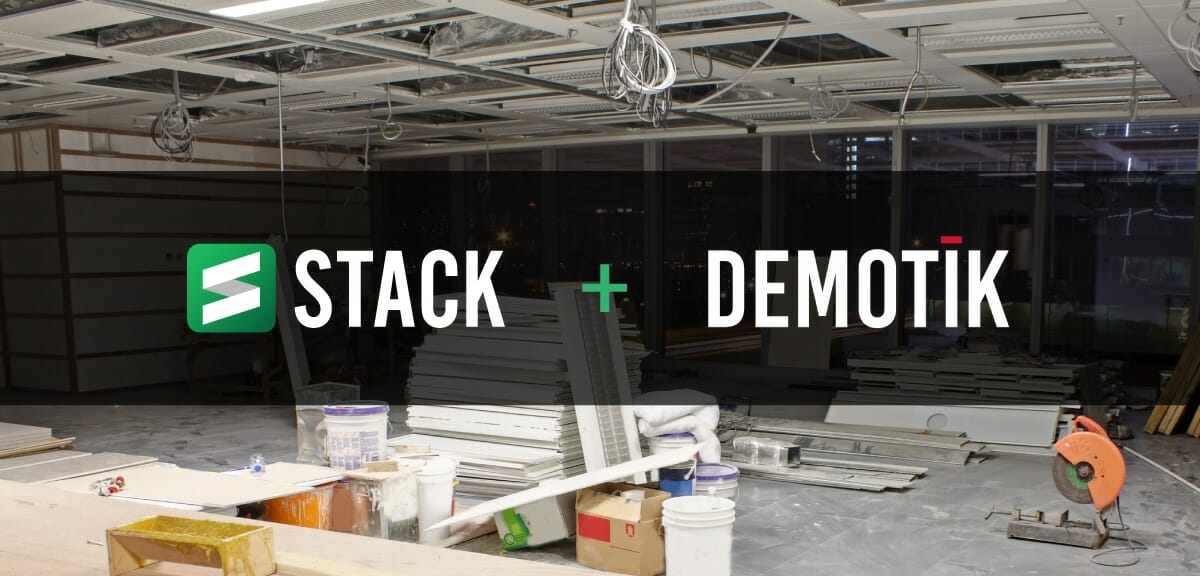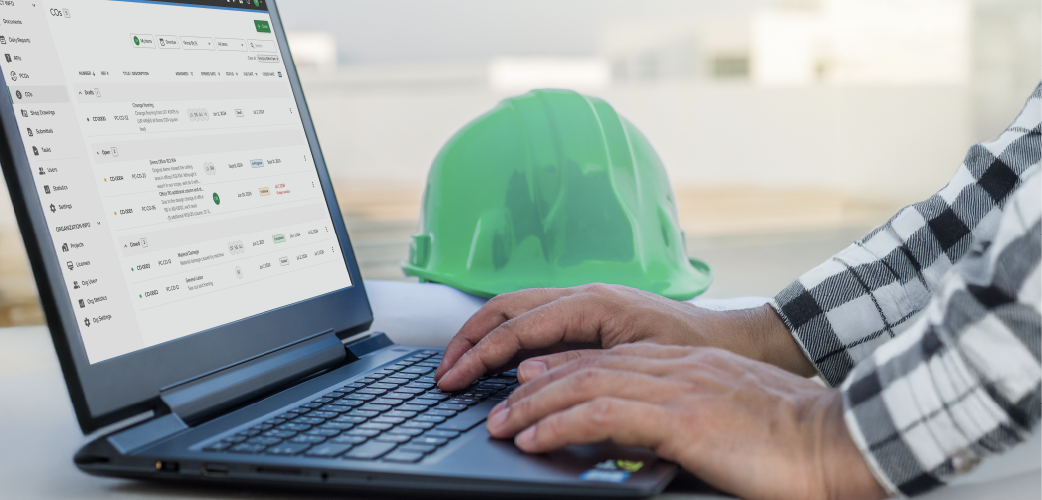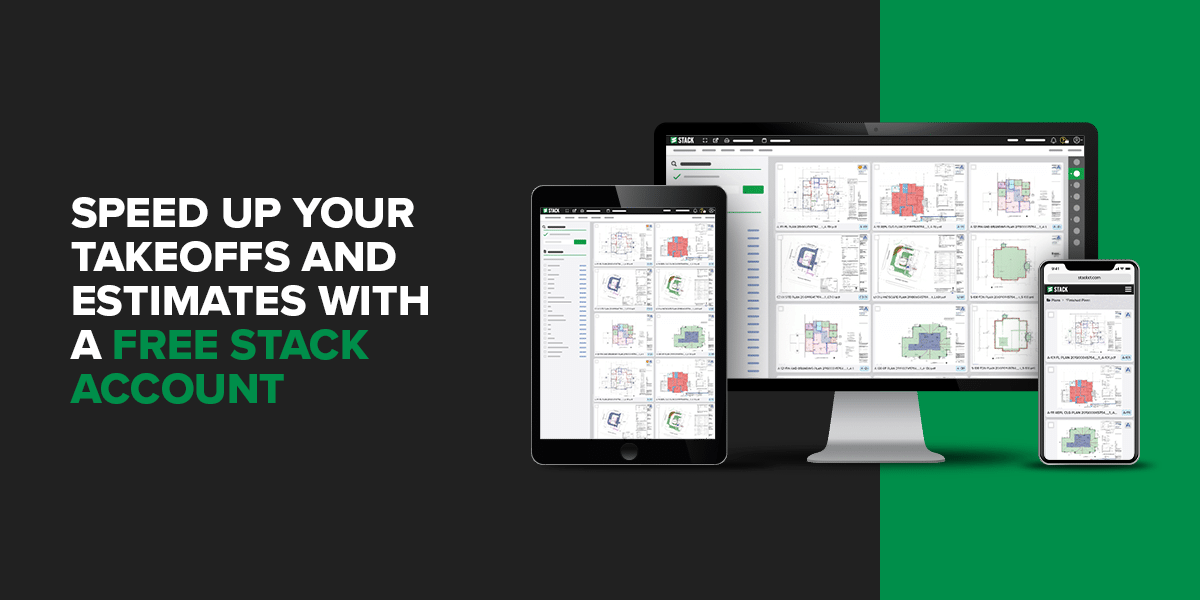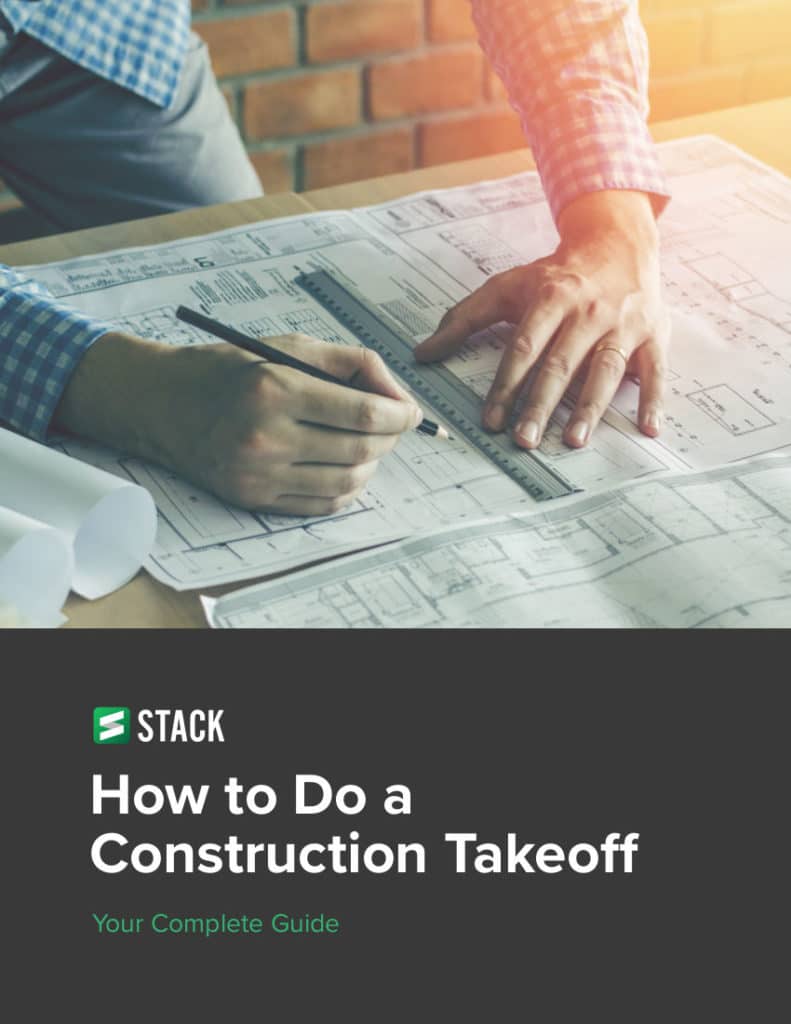If you’ve been in the construction business for any length of time, you probably know what a takeoff is or at the least have heard the term before. But if you’re new to the industry, there’s a good chance you don’t know what a takeoff is! With rising material costs, understanding takeoffs is key to predicting project costs and optimizing your bids. In this article, we’ll discuss construction takeoffs and how to conduct them more accurately.
In construction, a takeoff is the process where contractors determine how much of each material they will need to complete a project. A construction takeoff is an important step in estimating accurate project costs. Many also refer to it as a quantity or material takeoff.
Contractors use takeoffs in construction for many reasons including, submitting a bid for a job, creating an estimate for a job or simply determining how much of each material to buy. Let’s take a quick look at each of these scenarios:
- Submitting a bid: When you bid on a job, it’s important to know how much of each material you’ll need so you can determine the material costs in your bid. Without this valuable info, you could underbid the job and lose money or overbid and miss out on the job. Instead, performing an accurate takeoff is an incredibly important factor in whether you win your bid.
- Creating an estimate: Part of creating an estimate is knowing how much material you’ll need. You could just give it your best guess or perform a takeoff and get a lot more accurate information. Once you know how much material you need, you can price everything, add in your labor hours, tax, waste percentage and other costs to complete your estimate.
- Figuring out how much material to buy: Even if you aren’t submitting a bid or developing an in-depth estimate, you’ll still need to know how much material to buy. Under-buying is less than ideal because it causes jobsite delays and extra trips to buy more materials. Over-buying has more consequences because it cuts into your profit (and that’s something no one likes)!
As you can see, there are many reasons why you might want to do a takeoff in construction. In fact, if you’re working off of blueprints, there’s really no reason why you wouldn’t need to perform a takeoff. With a takeoff, you can more accurately estimate materials, saving you time and money as you work on your project.
Bid Faster. Win More. Build Smarter.
Get your FREE account today to:
- Increase Team Efficiency
- Complete Estimates Faster
- Generate More Revenue
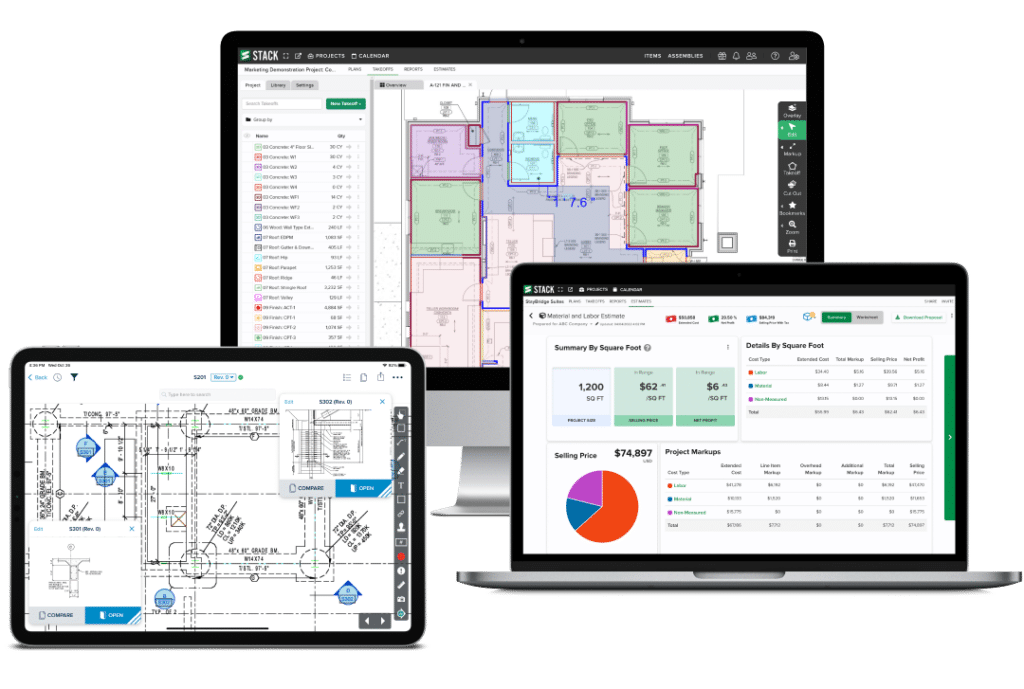
Before beginning a takeoff, an estimator should thoroughly review project plans to ensure all necessary materials are included and that the prospective project lines up appropriately with the company’s strengths and timeline. Then, you’ll need to do a count for materials like fixtures and outlets, and measure linear, area, volume, or other dimensions as needed to determine the amounts of materials required. Finally, calculate material costs based on amounts and factor in other costs to create your estimate.
A thorough review of project plans and specs is important to avoid wasting time bidding on projects that aren’t the right fit or spending time on your takeoff before you have everything you need to complete an estimate. Account for everything you received in the invitation to bid and ensure you understand the scope of the work, the anticipated timelines for both the construction project itself and the bid deadline, and any other specific aspects of the job, such as types of materials required or brand manufacturers the architect specifies must be included in the build. This way you’ll only invest your time in projects you know your company can win and complete successfully.
For trades such as mechanical, electrical, and plumbing, performing counts for materials like light fixtures, sinks, and other items is essential for estimating project cost. In a traditional paper takeoff, this process is time-consuming and prone to errors, since you must go through each plan page manually, generally with different colored highlighters, looking for the appropriate symbols for each type of material and keeping count. But with a digital tool, construction takeoff software can automatically identify the symbols for each material and calculate the number that appear on all the plan pages, populating your estimate with the needed quantities.
To determine the amount of materials such as lumber or concrete needed for a project, you’ll need to measure walls or landscape areas on plans and calculate based on square footage, volume, or any number of other dimensions. Traditionally, this was done on paper with a ruler, which was a lengthy process that was prone to human error. But with digital takeoff tools, you can perform takeoffs with just a few clicks, while also building items and assemblies into your takeoff to automatically calculate the amount of materials needed – not only your lumber, for example, but also how many nails you’ll need.
Once you have your counts and measurements, you’ll know how much materials are needed for the project. But there are many more factors to a construction estimate than just materials. Cost estimation software will allow you to adjust for labor, waste, taxes, overhead, any markups, and other considerations. It’s extremely important to generate accurate estimates because if you submit a bid that is too high, you’ll price yourself out of the job, but if you win a job on a low bid, you’ll eat into your profits and end up losing money.
As you begin working in the construction industry, you will want to know the difference between a takeoff and an estimate. A takeoff is simply determining the amount of all the materials needed for a job. That’s it! Takeoffs don’t include any material costs associated with them or extra costs that an estimate will have.
In contrast, an estimate takes the takeoff a few steps further. Estimates apply costs to all the materials determined by the takeoff and add in other costs the contractor will face. These extra costs include things like travel costs, tax, applying a waste factor, labor costs and any other extra costs you’ll face while completing that project. Many contractors often use a construction cost estimating software to make the job easier.
Contractors and subcontractors are the main people involved in doing takeoffs. Because they are the ones completing the project and are experts in their field, they have the qualifications to determine the supplies required to finish a project. However, some contractors may work with an estimator, who will take the contractor’s takeoff proposal and assign prices to the amounts listed. Construction cost estimating is one of the key parts of the process.
When writing a takeoff for a construction project, contractors need to include various information about the project to pass along the most accurate prices and amounts. Takeoffs should include all materials involved in the construction project, including raw materials to build features and add manufactured fixtures to a more completed project. Both are essential parts of the project and contribute to its cost.
Common examples of raw materials include things like wood, concrete and steel, which contractors can use to build other structures and features. Examples of manufactured fixtures include lights, cables, pipes and windows.
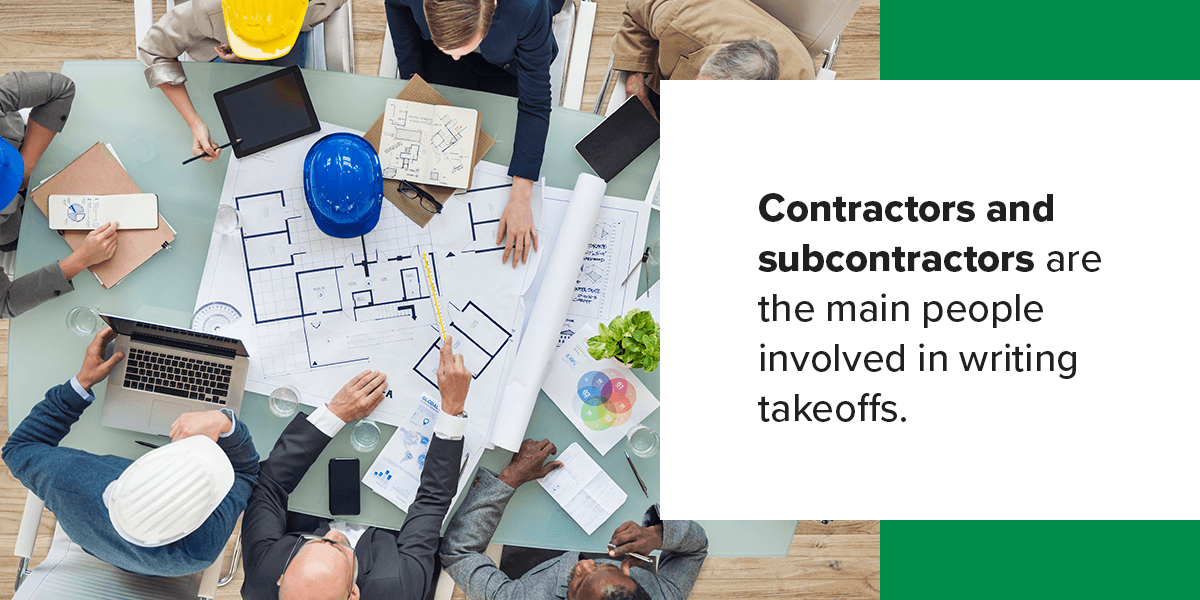
There are two ways that takeoffs can be performed — manually and digitally. Contractors complete manual takeoffs using physical blueprints that they print out. To do your takeoff, you measure the blueprint using a scale ruler to get the dimensions you need.
For example, if you’re painting a room, you’ll measure all four walls of the room, calculate the square footage, calculate the negative space you won’t need to paint from doors, windows and entryways and subtract that from the total square footage. Once you have that, you’ll figure out how much paint you need to paint that square footage by dividing the square footage by how much coverage a gallon of paint will provide.
Although this is probably the simplest example possible, there are still a lot of measurements and calculations that contractors need to make to come to the correct amount of materials you’ll need. It’s easy to measure something wrong or make a mistake calculating which can be costly, especially when you’re doing a big job.
Digital takeoffs use takeoff software and digital blueprints. The first step is to load your plans into the takeoff software. After it uploads, you can get started measuring your plans using the takeoff tools in the software. This is a simple process that involves using your computer’s mouse to click around the blueprint to measure the walls, floors, pipe lengths or other elements you may need to measure.
The great thing about digital takeoffs is that the software does all the calculations for you, which results in little to no mistakes! You’ll also know the exact amount of materials you’ll need every time!
- Raw materials: When incorporating raw materials into calculations, contractors need to include their dimensions so they can calculate with accuracy. These dimensions include factors like height, width, depth and even weight.
- Manufactured fixtures: Because manufactured fixtures come with a set price, contractors only need to include the estimated quantity they need in their takeoff to provide an accurate price.
- Materials for flat surfaces: Contractors use some manufactured features, like roofing and tiling materials, to create flat surfaces within their projects. Because they are flat, estimators don’t need their dimensions like raw materials. Instead, contractors need to provide the area these materials will cover to provide an accurate price for this construction element.
We’ve already touched on several of the benefits of using takeoff software over performing takeoffs by hand, but let’s examine some more reasons to use takeoff software:
- Speed: Using takeoff software is so much faster than manual takeoffs. While manually calculating takeoffs can take hours days, a software can make the same calculations in less time. Saving time pays off on small jobs but can make a huge difference if you’re working on a large project.
- Accuracy: There is lots of room for error when measuring by hand and using a calculator for calculations. To say the least, these errors can be costly! Let takeoff software do all your calculations for you so you don’t have to worry about errors anymore.
- Access: If you’re using cloud-based takeoff software, where you can log into it from your web browser, your plans will be available to you whenever you have an internet connection. This means you can access them from work, home, while traveling or even on the jobsite! It’s a great convenience when you need to review something or check out the material quantities you need.
- Organization: If you’ve been dealing with printed blueprints, you know how difficult it is to stay organized when you have piles of them laying around. Even finding the right one can be a challenge! When using digital takeoff software, you’ll simply search for the project name and the blueprint will come right up in the software. No more stacks of blueprints cluttering up the office!
If your company is looking to minimize waste and support sustainable building practices, an easy place to start is by increasing the accuracy of your construction estimates. Accurate takeoffs involve precise calculations of the quantities of materials needed for a construction project. This precision helps ensure that only the necessary amount of materials is ordered, reducing the likelihood of excess. When fewer materials are over-ordered, less waste is generated on-site, which directly contributes to more sustainable construction. Additionally, minimizing waste also reduces the environmental impact associated with the disposal of surplus materials, which can include transportation emissions and landfill use.
By providing detailed information on material requirements, accurate takeoffs enable better planning and procurement strategies. You can optimize the use of resources, ensuring that materials are used efficiently and that the quality of construction is not compromised. This optimization can lead to a reduction in the need for additional materials, further conserving natural resources. Moreover, it can help in selecting materials that are locally sourced, recycled, or have a lower environmental impact, aligning with sustainable building goals.
Accurate takeoffs can also support the adoption of environmentally friendly construction methods. For instance, by knowing the exact quantities of materials required, you can plan for modular construction or prefabrication, which often results in less waste and higher energy efficiency.
Improving construction takeoff processes makes a real impact to thousands of companies across the globe. STACK customers report significant results, from getting more bids out the door, to winning more work, to building confidence to go after larger, more complex jobs. Don’t take our word for it – see it in their own words! Take a look at our many happy customers!
Easy! Many takeoff software vendors offer free 7-day or 10-day trials of their software. It’s a great way to test them out and see if you like using them. Unfortunately, after that, the trial ends, often before you’ve had enough time to really try out the software.
At STACK, we offer a completely free version of our quantity takeoff software. It’s not a trial, so you are welcome to use it for as long as you’d like. Take your time and give it a spin! Of course, we also offer paid versions of our takeoff software which offers additional features that many contractors find useful. Discover a new way to complete takeoffs for construction projects and sign up for a free STACK account today!
Creating an accurate takeoff is essential for contractors to generate successful bids and earn more revenue on their projects. Using takeoff software can benefit contractors greatly by giving them an easy-to-use interface that will save them time and create more precise measurements.
Contractors use STACK every day to power a better preconstruction process. Our software helps provide a modern solution to a longstanding step in construction and contracting with a cloud-based system you can access anywhere you have internet access. Our cost estimating software comes with the ability to collaborate with other teams in real-time and helps create professional and branded bid proposals.
Speed up your takeoff process, get accurate measurements, bid and win more profitable work with STACK’s takeoff software. Get started today and sign up for free, or contact STACK Construction Technologies with any questions about how our software can serve your contracting projects.

